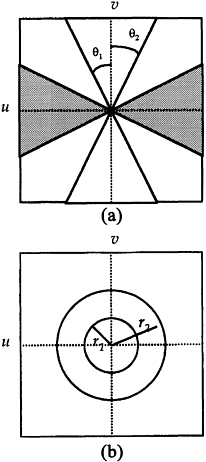126.
| [Cover] [Contents] [Index] |
Page 210
where θ and r denote angle and radius, respectively. Both θ and r control the width of the filter’s effective area. Equation (5.38) results in a wedge filter with a vertical alignment. If one wants to generate a wedge filter with a horizontal alignment, the value tan−1(v/u) in Equation (5.38) is altered to tan−1(u/v). A spatial interpretation of Equations (5.38) and (5.39) is shown in Figure 5.13. Note that in the calculation of the wedge filter, the value of P(0, 0) is normally omitted because it is common to all wedges. One can therefore calculate the percentage of power in the area of the amplitude spectrum that is covered by the wedge filter by dividing the sum of the amplitudes in the area covered by the filter by the total power spectrum.

Figure 5.13 (a) Two wedge filters, one in the vertical and the other in the horizontal direction, defined by angles θ1 and θ2. (b) A ring filter specified by radii r1 and r2. See text for further explanation.
| [Cover] [Contents] [Index] |
EAN: 2147483647
Pages: 354
- Chapter VII Objective and Perceived Complexity and Their Impacts on Internet Communication
- Chapter VIII Personalization Systems and Their Deployment as Web Site Interface Design Decisions
- Chapter X Converting Browsers to Buyers: Key Considerations in Designing Business-to-Consumer Web Sites
- Chapter XII Web Design and E-Commerce
- Chapter XVI Turning Web Surfers into Loyal Customers: Cognitive Lock-In Through Interface Design and Web Site Usability